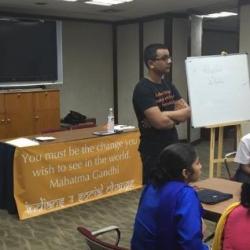PM Modi and India's New Foreign Policy
Background
The election of Narendra Modi marks a change, if not total reversal, of Indian foreign policy that we had seen under UPA I and II. The new focus is business and how India can better use its resources and human capital to lift more people out of poverty. This new business-centric approach has an impact on India’s relations with China, Japan and the United States.
India-China Relations
India and China have been warming up in the past decade. Modi visited Beijing 4 times during his tenure as Chief Minister of Gujarat. Each time, he was welcomed as if he was Prime Minister. His policies of cutting bureaucratic red tape and speeding up business licenses help Gujarat’s growth, as it averaged nearly double-digit growth during Modi’s tenure. China sees Modi’s business-centric stance as a means of expanding its markets. However, it also sees this as a way of trying to oppose U.S. efforts to ally with India as a counterbalance to China. A Delhi-Beijing axis based on business, Modi’s goal with regard to China, could be a strategic setback for the United States.
India-Japan Relations
Japan too views China as a useful counterbalance, but to Chinese influence instead of American. Prime Minister Shinzo Abe was one of the first foreign leaders to congratulate Mr. Modi on his victory. Japan views Modi’s business platform as a means of pairing Japanese technology and ingenuity with Indian human capital and resources. The alliance of the two nations could, in Mr. Abe’s view, revitalize a sluggish and ageing Japanese economy. For PM Modi, Japanese investment would allow him to replicate the miracle in Gujarat in other states across India.
India-United States Relations
The United States therefore has itself an interesting position regarding India. Mr. Modi was banned from coming to the U.S. in 2005 following his failure to prevent communal rioting in 2002. The U.S. now finds itself depending on Mr. Modi for strategic reasons. If he chooses to offer business deals with U.S. companies, both Mr. Modi and the United States can benefit from increased trade. However, at the moment, the U.S’s main goal is to prevent an Indian-Chinese axis, which Mr. Modi is fine with having. This is a cause of worry for the U.S., as a Sino-Indian axis could easily tip the balance of power against the U.S. in Asia, which is working on counterbalancing Chinese power through alliances with Japan and the Philippines.
Conclusion
With all this at stake, Mr. Modi’s decisions regarding a New Foreign Policy can have ramifications throughout Asia. It is his choice whether he aligns himself with the U.S., China or Japan. He could do so with all three. We’ll just have to watch and see how he deals with other nations in the coming months. The U.S., China and Japan will also be watching very closely.
[Image Attribute: PixalBay]




